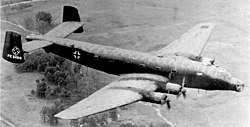Kampfgeschwader 200
| Kampfgeschwader 200 | |
|---|---|
Junkers Ju 290 A-7 | |
| Země | |
| Existence | 1944 - 1945 |
| Vznik | 1944 |
| Zánik | 1945 |
| Typ | bombardovací eskadra |
| Funkce | speciální eskadra pro tajné operace |
| Letouny | |
| Bombardovací | Mistel, B-24, B-17 |
Kampfgeschwader 200, nebo také zkráceně KG 200 byla oficiálně vedena jako bombardovací eskadra německé Luftwaffe za druhé světové války. Ve skutečnosti se jednalo o speciální eskadru pro tajné operace, nebo pro testování nově zaváděných, nebo ukořistěných strojů.[1]
Jednotka létala například s letadly Mistel[2] a s kořistními B-24, nebo B-17.[1]
Odkazy
Reference
- ↑ a b Kampfgeschwader KG 200 Archivováno 3. 5. 2018 na Wayback Machine na webu panzernet
- ↑ Beethoven Gerät neboli Mistel
Literatura
- STAHL, Peter W. Tajná eskadra KG200. Plzeň: Mustang, 1994. 147 s. ISBN 80-85831-09-0.
Související články
Externí odkazy
 Obrázky, zvuky či videa k tématu Kampfgeschwader 200 na Wikimedia Commons
Obrázky, zvuky či videa k tématu Kampfgeschwader 200 na Wikimedia Commons
Média použitá na této stránce
National flag and merchant ensign of Germany from 1933 to 1935.
National flag and merchant ensign of Germany from 1933 to 1935.
Ju 290 A-4, s/n 0165, PI+PS, was the prototype for the, renumbered "A3+HB", of KG 200. It had been equipped with attachments for FX 1400, Hs 293, and Hs 294 missiles, and fitted with FuG 203e radar, and was surrendered to the USA. Renamed "Alles Kaputt", and numbered "FE 3400", it was flown to the USA by USAAF Colonel Harold E. Watson from Orly, Paris to Wright Field, Ohio (USA), on 28 July 1945, via the Azores. The captured aircraft, with its German insignia repainted, was a frequent performer at air shows at Freeman Field and Wright Field. When the aircraft was scrapped at Wright Field in 1946, an plastic explosive device of German manufacture was discovered in the wing near to a fuel tank.


